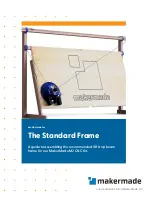
User Information Guide
EV1 Protective Helmets for
Structural Fire Fighting
ONLY THE END USER SHALL REMOVE THIS INFORMATION PRIOR TO USING THE HELMET
Introduction
This guide specifically addresses Honeywell EV1 protective helmets for structural firefighting (certified to NFPA 1971,
Standard on
Protective Ensembles for Structural Fire Fight Fighting and Proximity Fire Fighting
). An additional guide is provided for the Morning
Pride Ben 2 and Lite Force models. It is important to check the label inside your helmet to ensure that you have the correct guide
for type of firefighting helmet you have been provided. There are some differences in the care and maintenance of the different
types of helmets provided by Honeywell.
Your protective helmet is intended to provide protection to your head and portions of your face and neck as part of a properly
selected and configured protective ensemble during structural firefighting and proximity fire fighting. While your protective helmet
is designed to provide protection against a number of fireground and/or other emergency operations hazards,
your protective
helmet will not protect you against all exposures and under all conditions
, even when worn properly.
This user information guide provides information and instructions related to the selection, use, care, and maintenance of your
protective helmet. However, this guide does not tell you when and under what circumstances you should wear your protective
helmet. Rather, this guide tells you how to wear your protective helmet and provides an understanding of the limitations of your
helmet in how it may or may not protect you. Determination of the suitability of your protective helmet for specific emergency
operations rests with your department or employer, who has the legal responsibility to conduct a hazard assessment and decide if
your protective helmet provides appropriate protection against identified hazards.
While this guide provides you basic information to adequately care for and maintain your protective helmet, there are certain
additional procedures – such as advanced inspection, advanced cleaning, decontamination, and retirement – that should
be performed only by trained and qualified personnel. Information and instructions for these additional procedures are
provided on our website. Go to ww.HoneywellFirstResponder.com.
• DO NOT USE YOUR PROTECTIVE HELMET IF YOU HAVE NOT READ AND UNDERSTOOD THIS GUIDE AND THE
LABEL ON YOUR HELMET, AND HAVE NOT BEEN PROPERLY TRAINED AND SUPERVISED IN ITS USE.
• THIS HELMET AND ANY OTHER HELMET WILL NOT PROTECT YOU FROM ALL HAZARDS UNDER
ALL CONDITIONS.
• THIS HELMET MUST BE WORN AS PART OF A COMPLETE PROTECTIVE ENSEMBLE; IT IS THE RESPONSIBILITY
OF YOUR DEPARTMENT TO DETERMINE WHEN THIS HELMET MUST BE WORN TOGETHER WITH OTHER
ENSEMBLE ELEMENTS AND TO ENSURE THAT THE SELECTED ENSEMBLE ELEMENTS WORK TOGETHER TO
PROVIDE THE INTENDED PROTECTION.
• YOU MUST CORRECTLY ADJUST YOUR HELMET SUCH THAT IT PROPERLY FITS ON YOUR HEAD AND ENSURE
THAT IT IS PROPERLY DONNED WITH ALL COMPONENTS IN PLACE AND FULLY DEPLOYED.
• YOU MUST PROPERLY INSPECT, CARE FOR, AND MAINTAIN THIS HELMET WITH THIS GUIDE IN ORDER FOR
THE HELMET TO PROVIDE EFFECTIVE PROTECTION.
YOU MAY DIE OR SUSTAIN SERIOUS INJURY IF YOU DO NOT HAVE THE SPECIAL TRAINING AND
KNOWLEDGE TO CORRECTLY USE YOUR HELMET AND/OR HAVE NOT READ THIS USER GUIDE. IF
YOU WERE NOT GIVEN A COMPLETE GUIDE OR YOU LOSE YOUR USER GUIDE, ALERT YOUR
ORGANIZATION OR CONTACT HONEYWELL FOR A REPLACEMENT.
DANGER


























